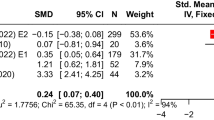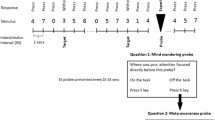Abstract
The experience of a wandering mind is common for most people, and it has been estimated that mind wandering occupies up to 46% of our thoughts during the day. There are recent studies showing entrainment effects leading to a decrease in mind wandering. However, it is not clear if there are state-dependent interventions that may provide a reduction of mind wandering. The main aim of the current study was to investigate in a university student population whether laboratory evidence of mind wandering can be reduced through two on-the-spot interventions; mindfulness meditation for 15 min (n = 25) and binaural auditory beats for a duration of 15 min (n = 27) relative to a no-intervention control group (n = 25). We measured levels of mind wandering at baseline across the three groups and after the 15-min interventions using the Sustained Attention to Response Task (SART). The results indicate that a short-term or on-the-spot mindfulness session for 15 min is successful in significantly reducing laboratory evidence of mind wandering. However, more surprisingly, we found that 15 min of auditory binaural beats also lead to a significant reduction of mind wandering, whereas the control group did not result in differences. We did not observe differences in mind wandering across the three groups at baseline or differences in stress levels across groups. The present outcomes are discussed in terms of the potential of using auditory binaural beats relative to mindfulness as a way to enhance cognitive control.


Similar content being viewed by others
References
Aguilar, M. M., Vergara, F. A., Velásquez, E. J., Marina, R., & García-Hermoso, A. (2015). Screen time impairs the relationship between physical fitness and academic attainment in children. Jornal de Pediatria, 91(4), 339–345.
Bakeman, R. (2005) Recommended effect size statistics for repeated measures designs. Behav Res Methods, 37(3), 379–84.
Bennike, I. H., Wieghorst, A., & Kirk, U. (2017). Online-based mindfulness training reduces mind wandering. J Cognitive Enhancement, 1(2), 172–181.
Brefczynski-Lewis, J. A., Lutz, A., Schaefer, H. S., Levinson, D. B., & Davidson, R. J. (2007). Neural correlates of attentional expertise in long-term meditation practitioners. Proceedings of the National Academy of Sciences, USA, 104, 11483–11488.
Carter, J. L., & Russell, H. L. (1993). A pilot investigation of auditory and visual entrainment of brain wave activity in learning disabled boys. Texas Research, 4, 65–75.
Chaieb, L., Wilpert, E. C., Reber, T. P., & Fell, J. (2015). Auditory beat stimulation and its effects on cognition and mood states. Frontiers in Psychiatry, 6, 70. https://doi.org/10.3389/fpsyt.2015.00070.
Chambers, R., Lo, B. C. Y., & Allen, N. B. (2008). The impact of intensive mindfulness training on attentional control, cognitive style, and affect. Cognitive Therapy and Research, 32, 303–322.
Cheyne, J. A., Solman, G. J. F., Carriere, J. S. A., & Smilek, D. (2009). Anatomy of an error: a bidirectional state model of task engagement/disengagement and attention-related errors. Cognition, 111, 98–113.
Cohen, S., Kamarck, T., & Mermelstein, R. (1983). A global measure of perceived stress. Journal of Health and Social Behavior, 24, 386–396.
Colzato, L. S., Barone, H., Sellaro, R., & Hommel, B. (2017). More attentional focusing through binaural beats: evidence from the global-local task. Psychological Research, 81(1), 271–277.
Craik, F. I. M. (2014). Effects of distraction on memory and cognition: a commentary. Frontiers in Psychology, 5, 841. https://doi.org/10.3389/fpsyg.2014.00841.
Deasy, C., Coughlan, B., Pironom, J., Jourdan, D., & Mannix-McNamara, P. (2014). Psychological distress and coping amongst higher education students: a mixed method enquiry. PLoS One, 9(12), e115193.
Erisman, S., & Roemer, L. (2010). A preliminary investigation of the effects of experimentally induced mindfulness on emotional responding to film clips. Emotion, 10, 72–82.
Farley, J., Risko, E. F., & Kingstone, A. (2013). Everyday attention and lecture retention: the effects of time, fidgeting, and mind wandering. Frontiers in Psychology, 4, 619.
Friedman, T. (2006). The age of interruption. The New York Times.
Gazzaley, A., & Rosen, L. D. (2016). The distracted mind: ancient brains in a high-tech world. MIT Press.
Gratz, K. L., & Roemer, L. (2004). Multidimensional assessment of emotion regulation and dysregulation: development, factor structure, and initial validation of the difficulties in emotion regulation scale. Journal of Psychopathology and Behavioral Assessment, 26, 41.
Hafenbrack, A. C. (2017). Mindfulness meditation as an on-the-spot workplace intervention. Journal of Business Research, 75, 118–129.
Jett, Q. R., & George, J. M. (2003). Work interrupted: a closer look at the role of interruptions in organizational life. The Academy of Management Review, 28, 494–507.
Jha, A. P., Stanley, E. A., Kiyonaga, A., Wong, L., Gelfand, L. (2010) Examining the protective effects of mindfulness training on working memory capacity and affective experience. Emotion, 10(1), 54–64.
Jha, A. P., Morrison, A. B., Dainer-Best, J., Parker, S., Rostrup, N., & Stanley, E. A. (2015). Minds “at attention”: mindfulness training curbs attentional lapses in military cohorts. PLoS One, 10(2), e0116889.
Jiang, Z., & Zhao, X. (2016). Self-control and problematic mobile phone use in Chinese college students: the mediating role of mobile phone use patterns. BMC Psychiatry, 16(1), 416.
Kabat-Zinn, J. (1990). Full catastrophe living: using the wisdom of your body and mind to face stress, pain and illness. New York: Delta Trade.
Kabat-zinn, J. (2003). Mindfulness-based interventions in context: past, present, and future. Clinical Psychology: Science and Practice, 10(2), 144–156. https://doi.org/10.1093/clipsy/bpg016.
Kabat-Zinn, J., Massion, A. O., Kristeller, J., Peterson, L. G., Fletcher, K. E., Pbert, L., et al. (1992). Effectiveness of a meditation-based stress reduction program in the treatment of anxiety disorders. The American Journal of Psychiatry, 149, 936–943.
Kennel, S., Taylor, A. G., Lyon, D., & Bourguignon, C. (2010). Pilot feasibility study of binaural auditory beats for reducing symptoms of inattention in children and adolescents with attention-deficit/hyperactivity disorder. Journal of Pediatric Nursing, 25(1), 3–11.
Killingsworth, M. A., Gilbert, D. T. (2010). A wandering mind is an unhappy mind. Science, 12;330(6006):932. https://doi.org/10.1126/science.1192439.
Lane, J. D., Kasian, S. J., Owens, J. E., & Marsh, G. R. (1998). Binaural auditory beats affect vigilance performance and mood. Physiology & Behavior, 63(2), 249–252.
Lin, B. C., Kain, J. M., & Fritz, C. (2013). Don’t interrupt me! An examination of the relationship between intrusions at work and employee strain. International Journal of Stress Management, 20(2), 77–94.
Lindquist, S. I., & McLean, J. P. (2011). Daydreaming and its correlates in an educational environment. Learning and Individual Differences, 21, 158–167.
Morrison, A. B., Goolsarran, M., Rogers, S. L., & Jha, A. P. (2014). Taming a wandering attention: short-form mindfulness training in student cohorts. Frontiers in Human Neuroscience, 7, 897.
Mrazek, M. D., Smallwood, J., & Schooler, J. W. (2012). Mindfulness and mind-wandering: finding convergence through opposing constructs. Emotion, 12(3), 442–8.
Mrazek, M. D., Franklin, M. S., Phillips, D. T., Baird, B., & Schooler, J. W. (2013). Mindfulness training improves working memory capacity and GRE performance while reducing mind wandering. Psychological Science, 24(5), 776–781.
Peiró-Velert, C., Valencia-Peris, A., González, L. M., García-Massó, X., Serra-Añó, P., & Devís-Devís, J. (2014). Screen media usage, sleep time and academic performance in adolescents: clustering a self-organizing maps analysis. PLoS One, 9(6), e99478.
Reedijk, S. A., Bolders, A., & Hommel, B. (2013). The impact of binaural beats on creativity. Frontiers in Human Neuroscience, 7, 786.
Robertson, I. H., Manly, T., Andrade, J., Baddeley, B. T., & Yiend, J. (1997). ‘Oops!’: Performance correlates of everyday attentional failures in traumatic brain injured and normal subjects. Neuropsychologia, 35(6), 747–758.
Szpunar, K. K., Moulton, S. T., & Schacter, D. L. (2013). Mind wandering and education: from the classroom to online learning. Frontiers in Psychology, 4, 495.
Vernon, D., Peryer, G., Louch, J., & Shaw, M. (2012). Tracking EEG changes in response to alpha and beta binaural beats. International Journal of Psychophysiology, 93(1), 134–139.
Ward, A. F., Duke, K., Gneezy, A., & Bos, M. W. (2017). Brain drain: the mere presence of one’s own smartphone reduces available cognitive capacity. Journal of the Association for Consumer Research, 2(2), 140–154.
Zheng, F., Gao, P., He, M., Li, M., Wang, C., Zeng, Q., Zhou, Z., Yu, Z., & Zhang, L. (2014). Association between mobile phone use and inattention in 7102 Chinese adolescents: a population-based cross-sectional study. BMC Public Health, 14, 1022.
Author information
Authors and Affiliations
Corresponding author
Ethics declarations
Conflict of Interest
The authors declare that they have no conflict of interest.
Ethical Approval
All procedures performed in studies involving human participants were in accordance with the ethical standards of the national research committee and with the 1964 Helsinki declaration and its later amendments or comparable ethical standards.
Additional information
Publisher’s Note
Springer Nature remains neutral with regard to jurisdictional claims in published maps and institutional affiliations.
Rights and permissions
About this article
Cite this article
Kirk, U., Wieghorst, A., Nielsen, C.M. et al. On-the-Spot Binaural Beats and Mindfulness Reduces Behavioral Markers of Mind Wandering. J Cogn Enhanc 3, 186–192 (2019). https://doi.org/10.1007/s41465-018-0114-z
Received:
Accepted:
Published:
Issue Date:
DOI: https://doi.org/10.1007/s41465-018-0114-z




